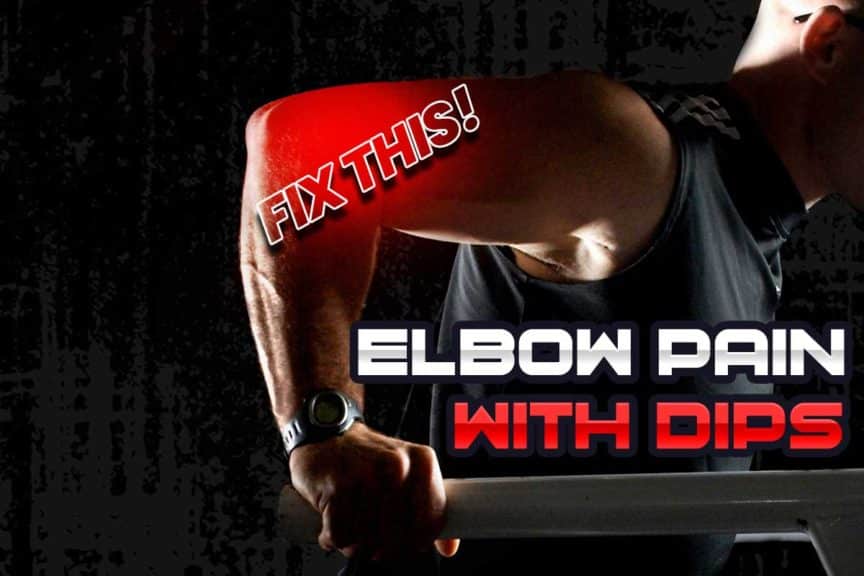Few upper body exercises can rival dips’ strength and muscle-building effects. After all, not only do dips hammer the triceps muscles, but they also challenge and strengthen the upper pectoral fibers and anterior deltoid fibers. Unfortunately, they can also place great stress and strain on the elbow joint and triceps tendon under certain conditions.
So, if you’ve been getting elbow or triceps pain with your dips, you will want to read this article to arm yourself with the required knowledge to prevent or eliminate this annoying and often painful condition.
Elbow pain from dips most often results from excessive demand on the common triceps tendon, leading to pain. Solutions involve:
- Optimizing your technique.
- Changing your range of motion.
- Optimizing dip resistance.
- Utilizing specific tissue preparation techniques.
Naturally, there can be numerous reasons why you’re experiencing elbow discomfort or pain when doing your dips, so it’s best to seek out a qualified healthcare professional for an assessment to be certain of what’s causing your issue. Nonetheless, I’ll provide information on the most common reasons for elbow pain when dipping and strategies you may want to try to optimize your elbow health.
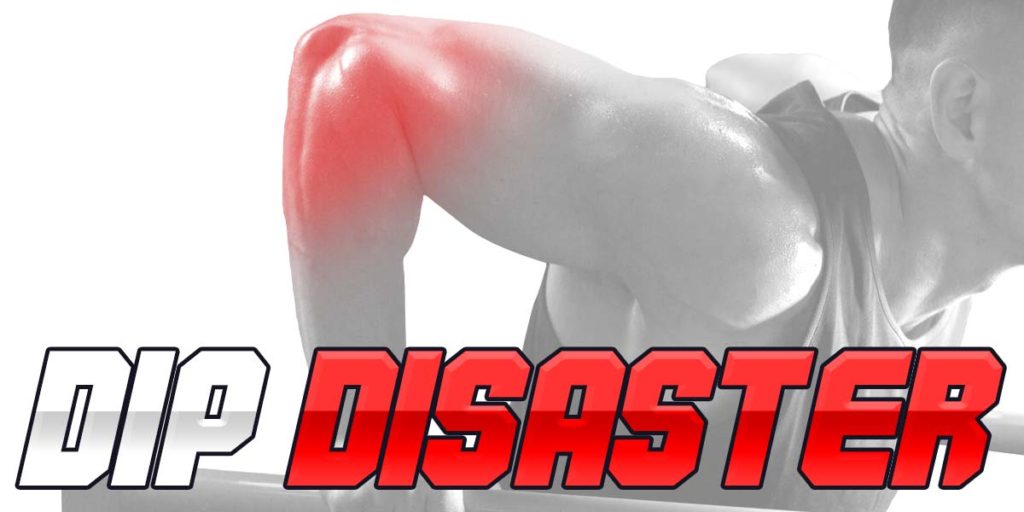
Related article: Why The Sphinx Push-up Reigns King For Triceps Strength and Size
As we dive into this article, keep in mind that what follows below applies to whether you’re doing your dips with your hand behind you on a bench or step or if you’re doing your dips between two bars.
Anatomy 101: The elbow
Before getting to some effective solutions, let’s do a super brief rundown on the basic anatomy that comprises the elbow and the tissues that are often involved when experiencing pain from dips. Not only will this basic understanding make the concepts of the topics within this article much easier to follow, but it will also make the following solutions and your overall recovery process much more intuitive. The result will be efficient recovery and a much lower likelihood of re-injury of your elbow.
Here’s your super brief rundown on the anatomy and structure of the elbow:
Joints of the elbow
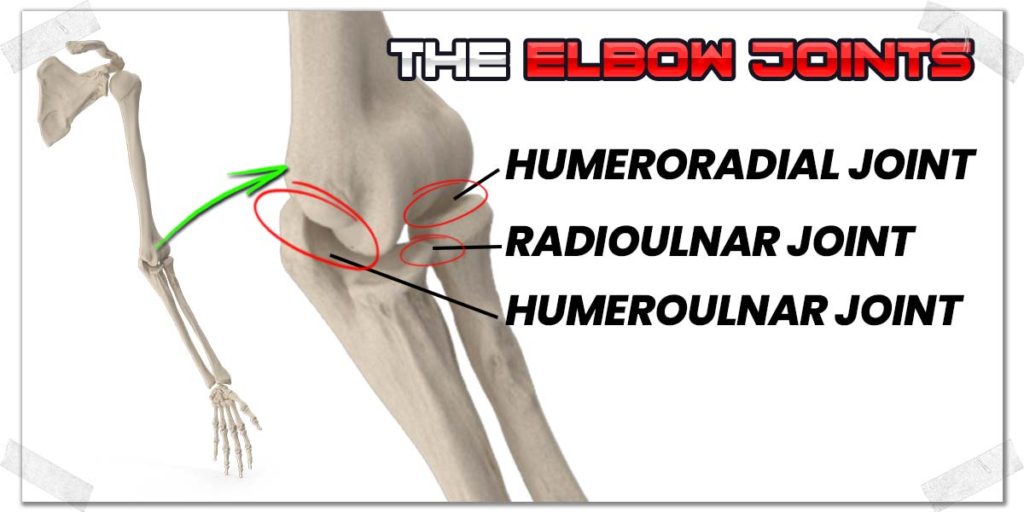
The elbow comprises three distinct joints, all of which work to afford us the movements that we expect from this body part. From being able to bend or straighten (flex or extend, respectively) the elbow to rotating the palms down or up (pronation and supination, respectively), these movements are a result of their respective joints, which are:
- The humeroulnar joint (helps bend and straighten the elbow)
- The radiohumeral joint (helps us turn our palm up and down)
- The radioulnar joint (helps us turn our palm up and down)
Joint pain can absolutely be a source of elbow pain when performing dips. However, it is less often implicated than soft-tissue causes (issues involving the muscles, tendons and ligaments). Common causes of joint pain in the elbow that are experienced with dips can include:
- Previous injury or trauma to the joint or the cartilage of the joint
- Arthritic or degenerative changes to the joint
Muscles and tendons that cross the elbow joint
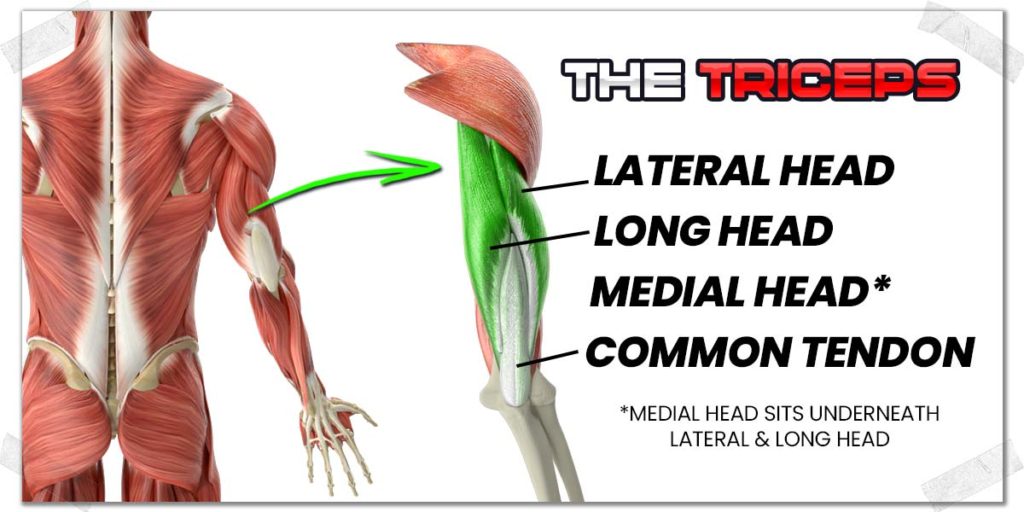
Multiple muscles cross over the elbow joints, which help to facilitate movement; however, for the sake of this article, I’ll be focusing on those most often involved with elbow pain when performing dips, which include:
- The common triceps tendon
- The forearm extensors & the common extensor origin
- The forearm flexors & the common flexor origin
Anatomy tip: A tendon is a structure that attaches a muscle to a bone. Tendons have a poor blood supply and, therefore, often have difficulty regaining total health when they’ve been unhealthy for a prolonged period.
Generally speaking, in my experience, the triceps tendon is most often involved with soft tissue pain experienced with dips since it undergoes the highest amount of repetitive force when straightening the elbow (i.e., when pushing upwards from the bottom of the dip). This intense demand, combined with high levels of repetition, is notorious for irritating the tendon, leading to acute bouts of tendonitis.
Nerves that cross the elbow joint
Three major nerves cross the elbow joint, all of which start from the neck and run down into the hand. These nerves are:
- The radial nerve
- The median nerve
- The ulnar nerve
Each of these nerves helps us to produce various movements of our arm and hand (which are therefore known as motor nerves) by carrying electrical signals from our brain while also supplying sensory information to our brain.
A few conditions involving the nerves can arise, which can cause or contribute to pain in or around the elbow. Keep on reading to learn more about the specifics regarding these conditions and how to best get them under control.
Bursas of the elbow
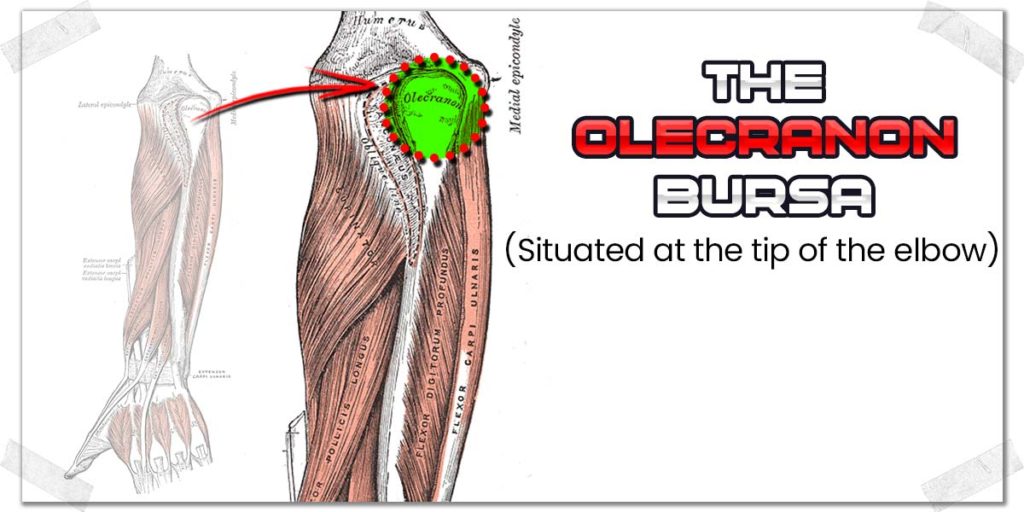
The human body is filled with a couple of hundred bursa pads, which are little fluid-filled sacs (think of them like little water balloons) that reduce the friction between a tendon and the bony surface(s) that the tendon moves over. Without these structures, our tendons would chronically be irritated, inflamed, and painful from constantly rubbing over bony surfaces.
The main bursa to be aware of in the elbow is the olecranon bursa, which sits essentially at the tip of the elbow. It is one of the most commonly irritated bursas, which can lead to an annoying and painful condition known as bursitis.
To learn more about how to deal with bursitis, keep on reading!
Sources of elbow pain
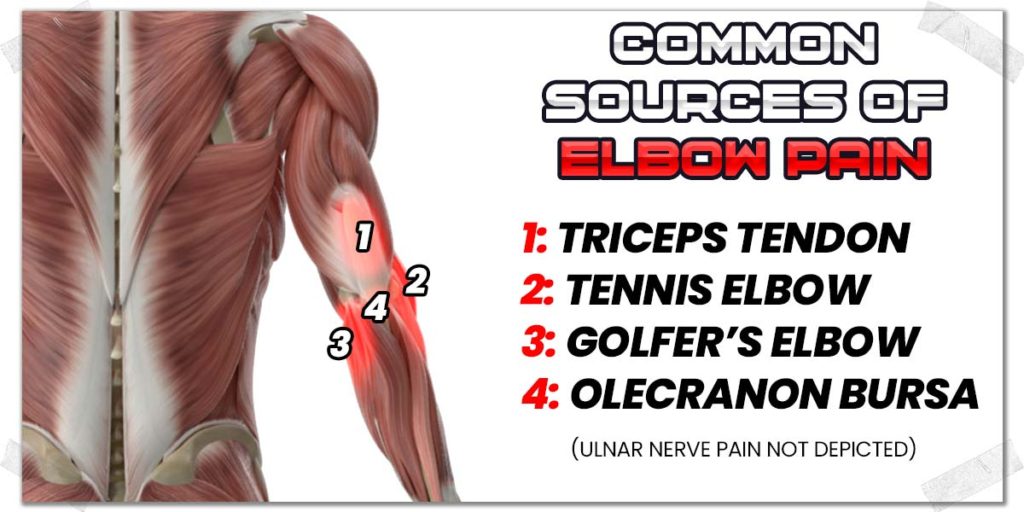
With a basic understanding of elbow anatomy now etched in your brain, it’s time to dissect the common pain-generating structures and mechanisms that can cause or contribute to the pain or discomfort you’re feeling in your elbow(s). Again, understanding these basics will make the recovery process more intuitive and effective. You’ll also be less likely to incur this same issue down the road since you’ll better understand what should be done to ensure the issue doesn’t arise again.
So, don’t skip this section!
Related article: Pain from Pullovers | Triceps | Shoulders | Chest (Causes & Fixes)
What follows below are the most common causes of elbow pain from dips. (Solutions will be discussed in the following section).
Tendinopathy
Tendinopathy is a non-specific or umbrella term for an unhealthy or painful tendon. It can include conditions such as tendonitis, tendinosis, and tenosynovitis. When it comes to dips, the most common cause of elbow pain that I tend to see in the gym and treat in the clinic is tendinosis.
The tendons of the elbow that can be affected when performing dips are:
- The common triceps tendon
- The tendons of the common flexor origin
- The tendons of the common extensor origin
What causes tendinopathy in the elbow can vary from one individual to the next; however, it’s most often the result of repetitive movements, often with excessive resistance. Hence, the repetitive microtrauma that tendons experience from dips can lead to an inadequate healing response (mainly in part due to their poor blood supply).
It’s important to note here that the common triceps tendon can often be directly impacted by dips, which can lead to tendinitis, whereas pain that arises in the common flexor and extensor origin when (or after) performing dips is likely secondary to the dips themselves.
In other words, dips likely aren’t the primary cause for any pain you’re experiencing in the flexor or extensor region but likely signify that these respective tissues are unhealthy due to other reasons and are simply being further irritated when doing your dips.
Pro tip: The term “tendonitis” refers to an unhealthy tendon with a notable amount of inflammation. “Tendinosis” refers to an unhealthy tendon that lacks any notable inflammation. The latter is much more common than the former.
Triceps tendonitis & tendinopathy
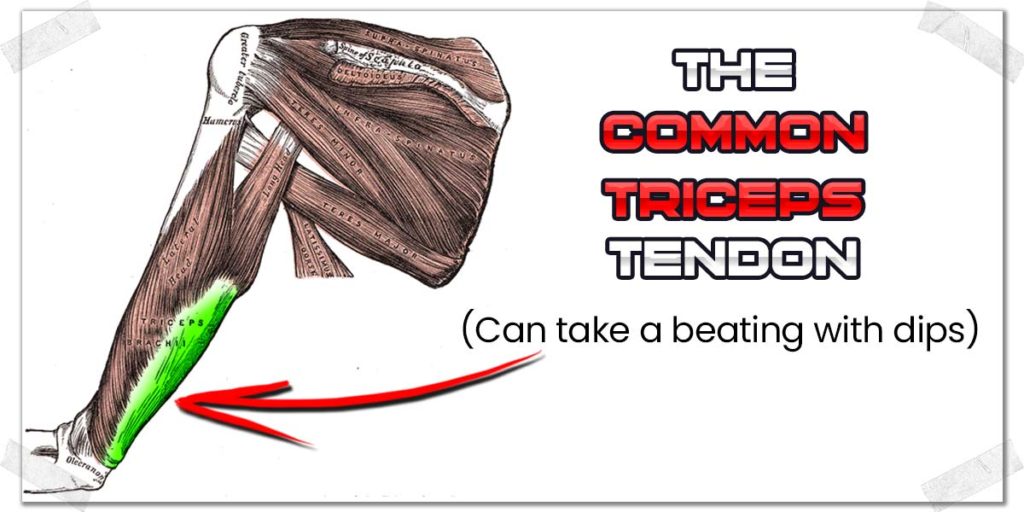
The common triceps tendon can take a pounding if you’re performing more repetitions or using more resistance (or both) than what the tendon can effectively tolerate. As a result of performing repetitive movement against resistance, the tendon can become inflamed, leading to tendonitis. While tendinosis (an unhealthy tendon without inflammation) of the triceps tendon isn’t overly common, it’s entirely possible to acutely irritate and inflame the triceps tendon.1 Still, I’ve generally seen more cases of triceps tendonitis than I believe I’ve seen tendinosis.
Tennis elbow (lateral epicondylalgia)
Tennis elbow is the most common tendinopathy within the elbow.2,3 It affects the extensor tendons (along the outer portion of the elbow) and is often provoked when grabbing, holding, and lifting objects.
In the case of dips, holding onto the dip handles can potentially cause the extensor tendons to become tense or irritated. Thankfully, this issue can be relatively straightforward to clean up if it hasn’t been present for an extended length of time (such as for six months or longer).
Golfer’s elbow (medial epicondylalgia)
Golfer’s elbow is the same condition as tennis elbow, except that it affects the flexor tendons on the inside of the elbow. Holding onto the dip handles can irritate these tendons, but thankfully, it can usually be cleaned up relatively easily with the proper steps.
Nerve entrapment & irritation
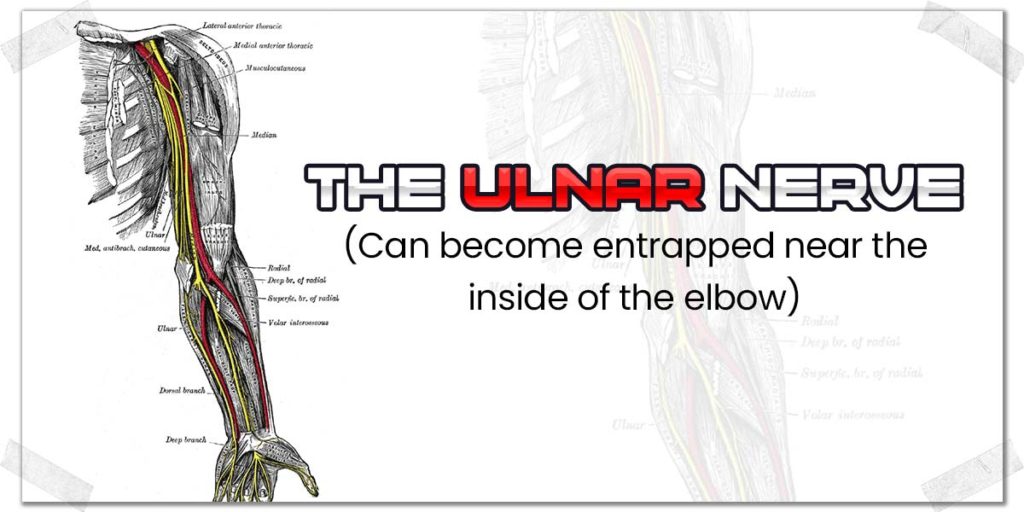
Nerves should be able to glide and move freely between the tissues they’re next against. However, for various reasons, sometimes nerves can become bound down or restricted in ways that prevent them from sliding as they otherwise should. When this happens, it can produce noticeable pain anywhere along the nerve, most often in the vicinity where the nerve is entrapped.
The specifics of nerve entrapment are a bit beyond the scope of this article. Still, it’s worth briefly mentioning that cubital tunnel syndrome, otherwise known as ulnar nerve entrapment, is the second most common type of nerve compression in the arm next to carpal tunnel syndrome (compression of the median nerve in the wrist) and can be a source of elbow pain from dips.4
It’s a good idea to get this issue checked out by a qualified healthcare professional, as the rehab can be a bit more detailed than standard muscle rehab. Learning some basic ulnar nerve glides will likely be a good starting point, but to make sure you’re getting to the root cause of the issue (just like with every other condition mentioned in this article), getting a proper evaluation is wise.
Pro tip: Nerve glides (a type of neurodynamic exercise) can be highly effective in improving nerve mobility. Check out the video below for a specific exercise that helps to improve the neurodynamics of the ulnar nerve, which is often impaired with conditions such as cubital tunnel syndrome.
Olecranon bursitis
When it comes to bursitis, the olecranon bursa is one of the most commonly afflicted bursas in the body, which is known as olecranon bursitis. Thankfully, it’s most often more of a self-limiting issue, and not much medical action needs to be taken so long as the pain is not extreme and the bursa is not infected. Anti-inflammatories can help, though this will certainly depend on your own individual circumstances.
Most often, olecranon bursitis resolves by eliminating irritating activities for the time being and avoiding excessive contact with hard surfaces (such as resting your elbow on a table) and being patient. Still, it’s never a bad idea to check in with a medical professional if the pain or swelling are becoming problematic, or you’re otherwise uncertain towards the current state of your elbow or bursa.
Solutions to elbow pain
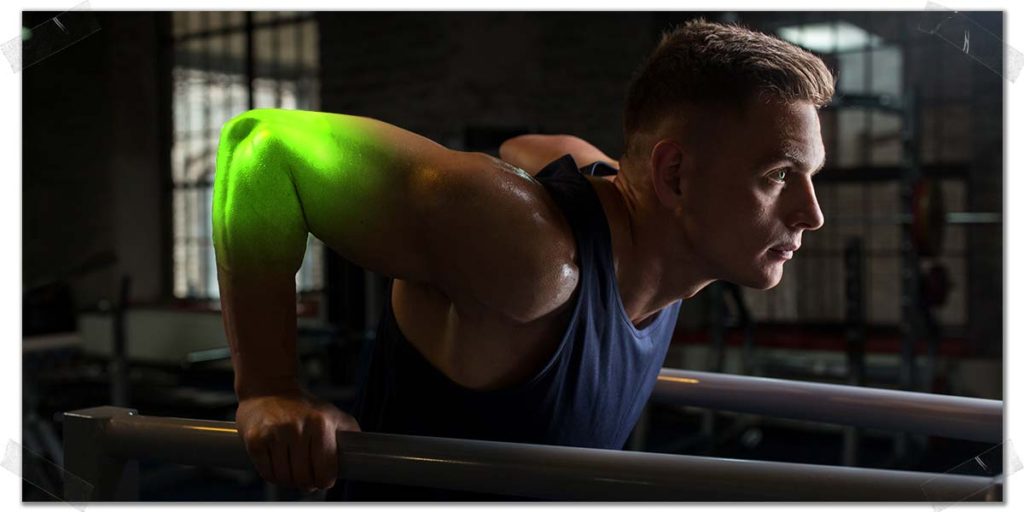
Fixing pain and dysfunction requires getting to the root of the problem. While I can’t cover every possible issue (and subsequent solution) that could be causing or contributing to your elbow pain, I can certainly cover the common, highly effective solutions that can significantly help the majority of lifters incurring elbow pain from dips.
The two major solutions to implement are to change up (thus fixing) your dipping technique if you’re using poor form and to perform soft tissue techniques to help keep the muscles and tendons as healthy as possible, which will allow them to better tolerate the forces and demands being placed upon them when dipping.
Let’s look at each of these solutions in more detail!
Technique changes
Poor or less-than-ideal technique is arguably the most common cause of elbow pain experienced from dips, mainly due to the excessive stress and strain forces it can place upon the elbow joints and subsequent tissues. Even slightly subpar technique can add up to a decent amount of discomfort or pain as time goes on. As such, it’s worth taking the time and effort to ensure that your technique is absolutely on point with every repetition you perform.
What follows are some of the most common technique flaws I witness with individuals and clients in the gym when performing dips between parallel bars.
Inappropriate elbow flare
Elbow flare refers to the extent to which your elbows point outwards when performing your dip. Too much or too little flare can lead to excessive stress and strain on the elbow’s triceps tendon or the joints. While the extent of ideal elbow flare can vary from one individual to the next, there are some general tips to follow to help ensure you’re not predisposing your elbow to unnecessary aches and pains:
- Don’t have your elbows pinned directly against your body
- Don’t have your elbows pointing directly out to the side
Take some time to play around with the angle flare that feels best for you. Remember, small changes can lead to substantial differences, so be mindful of your positioning and see how it’s tolerated by your elbow(s).
Pro tip: It has been shown that a wider width when performing vertical dips (dipping between bars) produces greater activation of the pectoral muscles. If using a wider bar width is an option for you, you can likely offload the triceps tendon a bit more by doing so since the pectorals will contribute to more of the movement.5
Angle of lean
If you’re performing dips using bars (as opposed to using a bench with your arms behind you), it’s a good idea to make sure you’re leaning forwards during the movement. While you might think your torso should be perfectly upright during the dip, it’s actually more advantageous to have a mild forward lean through your torso and upper body.
A forwards lean will help engage the upper pectoral fibers of the chest and the anterior deltoid fibers of the shoulder while offloading the otherwise excessive load that will run through the common triceps tendon at the elbow.
A strictly upright torso during dips will not only force the common triceps tendon to endure excessive stress but will likely also feel somewhat uncomfortable or unnatural.
Play around with your positioning if you’ve been staying completely upright with your dips. You don’t have to lean forwards much, but even a slight lean could help save your elbow(s) a decent amount of discomfort.
Range of motion
While using a full range of motion for your dips is beneficial, using a range of motion that is excessive or otherwise overly stressful on the elbow will likely only lead to pain or discomfort rather than any benefit.
The deeper into the dip you go, the further the elbow must flex (bend). While this large range of flexion typically isn’t problematic, coming out of this position (i.e., straightening the elbow) is, as it will force the common triceps tendon to contract with excessive effort from a rather stretched position, which can overload and irritate the tendon.
The solution is to use as much of a range of motion as possible when dipping, but only to the point that you don’t experience any tendon pain in the back of your elbow (or elsewhere) either during the exercise or thereafter.
Pro tip: Bending the elbow to 90 degrees during the dip is quite sufficient for reaping the strength-building benefits of dips. Going beyond this range can be tolerated by some individuals but likely isn’t necessary unless you have highly specific needs for your training/sport, especially if you’re new to the exercise.
Reducing load and training volume
While not the most enjoyable insight to hear, you might need to reduce the intensity of your dips for the time being. If you can use an assisted dip machine to decrease the forces and stresses running through your elbow so that you can do some lighter dips without pain, doing so is likely a smart move to make. This is, of course, assuming you’d still like to make an attempt to perform some dips while working through your elbow issue.
It may also be worth considering backing off the overall training volume you’re performing for your dips. Training volume refers to how many sets and reps, how much resistance, and how frequently you’re performing an exercise.
By reducing one or more aspects of your training volume, you might be able to perform your dips without incurring pain, depending on the severity and intensity of your elbow condition.
Tissue preparation & maintenance techniques
If you’re serious about keeping your body as healthy and active as possible, knowing how to generally and specifically treat your muscles, tendons, and joints is critical, be it for your elbow or any other region of your body.
The key is to know how to effectively prepare any body part immediately before exercising and have additional strategies that can be used either after a workout or at any other point outside of the gym. Read below for the general details regarding these strategies.
Related article: IASTM: Here’s How it Works to Decrease Pain and Improve Mobility
Thorough warmup
Prepping your joints, muscles, and tendons before a workout is a smart move to make. It’s an even smarter move to make — and one I would say is necessary — when you know that any exercises you might be doing can be somewhat stressful to any of those particular tissues or if you have a previous history of elbow pain or injury.
While there’s no single, universal way to prepare your elbow and surrounding tissues, here are some solid starting points to consider:
- A generalized warmup that helps to elevate blood flow throughout your body and increase your core temperature slightly can be beneficial. A simple, continuous five-minute exercise such as jogging on a treadmill, using a rowing machine, elliptical machine, etc., can help to achieve this effect.
- Dynamic exercises that (in this case) involve movements to the arms can further enhance the local tissue mobility and blood flow. These types of exercises have been shown to improve various qualities of muscles, making them ideal for performing as part of a warmup routine.
- A quick bit of myofascial work will likely be helpful too. Since this can be done as a warmup or as a general soft tissue technique outside of the gym, check out the section below for how to do some effective myofascial work on your elbow & triceps.
Soft tissue techniques
Implementing one or more soft tissue techniques regularly outside the gym is a habit worth getting into. It doesn’t have to be anything extensive in terms of it being time-consuming or with multiple techniques; just a quick two or three minutes a few times per week can make some profound differences in the overall mobility and health of your triceps.
What follows below are some highly beneficial home treatment techniques you can consider trying as part of an elbow maintenance routine.
Compression flossing (Voodoo flossing)
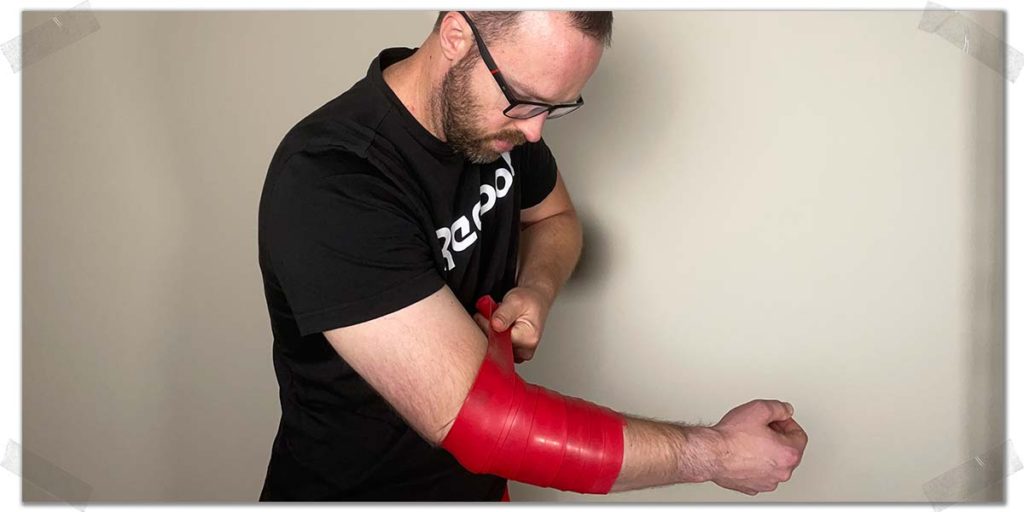
Compression flossing involves wrapping a flat latex band around a joint or muscles and performing movements that challenge the mobility of the muscles and joints underneath the band. It’s sometimes referred to as “tack and floss” or “pinning” a muscle.
By forcing muscle tissue beneath the compressive band to move, fascial adhesions can be broken up, which can help improve muscle and tendon mobility, improve localized blood flow and reduce sensitivity to pain.6
It’s believed that compression flossing can help joint mobility by working to optimize the joint’s mechanics and positioning, which can work to optimize movement, decrease pain, and improve joint health.
Check out my YouTube video below to learn how to compression floss your elbow!
Cross friction massage
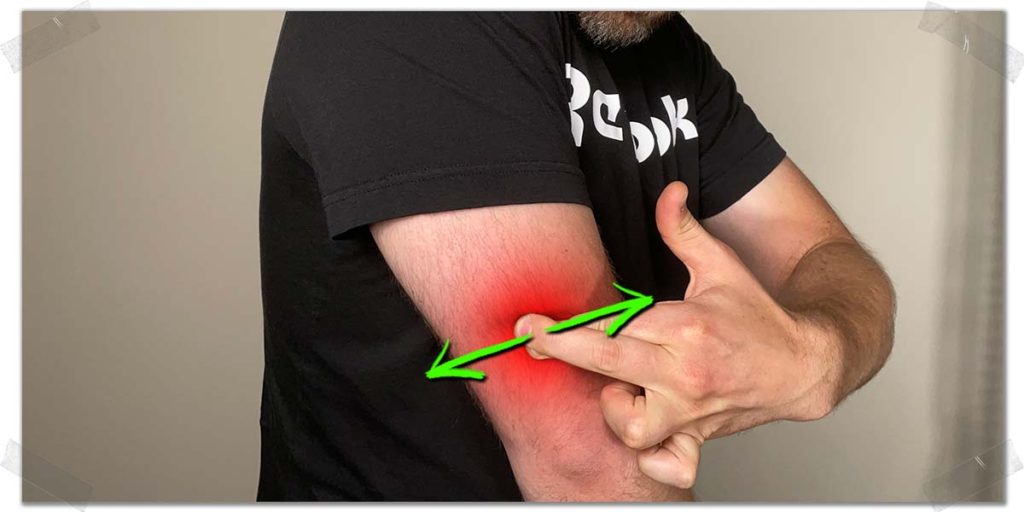
Cross friction massage is a beauty of a technique to keep a tendon healthy or get it healthier. It’s a technique that has been around for decades and has some decent evidence behind its effectiveness, particularly in treating the tendons of the elbow.7,8
Cross friction massage works by:
- Improving blood flow to the area being stimulated
- Reducing adhesions that are adversely affecting tendon mobility
- Decreasing mechanosensitivity of the tendon (making it less painful)
To perform the technique:
- Cross your middle finger over your pointer finger
- Place your fingers over the sore tendon(s) of your elbow (triceps tendon, extensor tendons, etc.)
- With mild pressure, roll your fingers back and forth perpendicular to the tendon itself. Go back and forth at a rate of about 3Hz.
- Perform for about 30 seconds.
Want more details? Check out this scientific article:
Triceps rolling
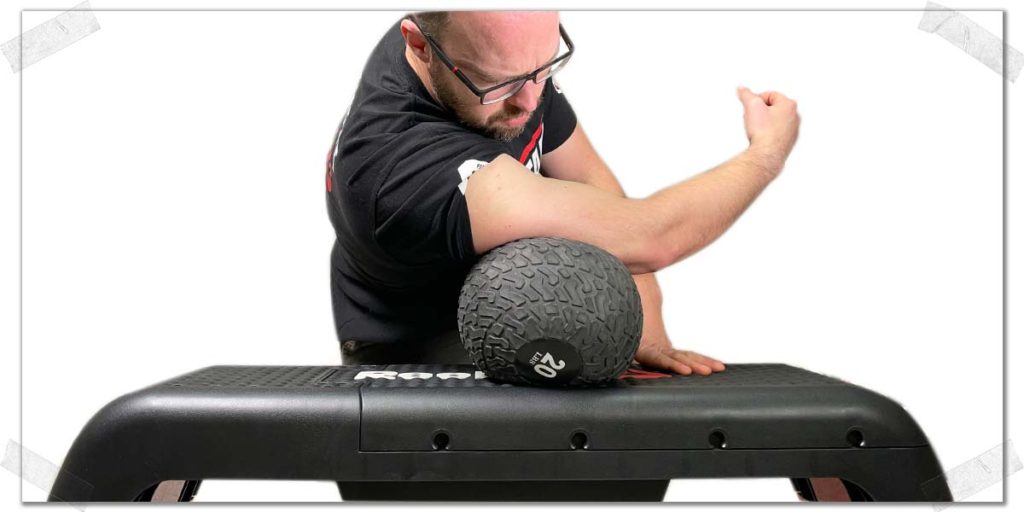
You know how people often perform foam rolling on their legs? Turns out you can do the exact same thing with your triceps. While there are different ways of doing so, my favorite involves using a medicine ball; however, you can also use a travel roller if you prefer.
Here’s how to roll your triceps:
- Grab a firm medicine ball or a travel roller and place it on a workout bench.
- Straighten your arm and place the back of your arm on the ball with your palm facing up.
- Push your arm forwards and backwards so the ball rolls up and down your triceps. Do this as many times as you’d like, then roll the ball across the triceps in the same manner.
Pro tip: The more firm the ball, the more tender your triceps will likely feel when rolling. If you find a rather tender spot on your triceps, try to roll over that area much more slowly; the slower you go, the more effective the treatment will likely be.
Final thoughts
Dips are too beneficial of an exercise to forego if you can help doing so. But simply pushing through elbow pain and hoping things get better on their own is not the approach to take. Make sure you take the time required to get to the root cause of your issue, then be smart about how you attack the problem. You’ll come out stronger on the other end and will likely be able to get back to dipping again before you know it.
References:
3. Lateral Epicondylitis. Physiopedia. Accessed September 1, 2022. https://www.physio-pedia.com/Lateral_Epicondylitis
4. Cubital Tunnel Syndrome. Physiopedia. Accessed September 1, 2022. https://www.physio-pedia.com/Cubital_Tunnel_Syndrome
6. Jianhong G, Soon CC, Seng TJ, Zaremohzzabieh Z, Samsudin S. The Effect of Tissue Flossing Technique on Sports and Injury Prevention and Rehabilitation: A Systematic Review of Recent Research. Published online 2021.
8. Chamberlain GJ. Cyriax’s friction massage: a review. J Orthop Sports Phys Ther. 1982;4(1):16-22.

Hi! I’m Jim Wittstrom, PT, DPT, CSCS, Pn1.
I am a physical therapist who is passionate about all things pertaining to strength & conditioning, human movement, injury prevention and rehabilitation. I created StrengthResurgence.com in order to help others become stronger and healthier. I also love helping aspiring students and therapists fulfill their dreams of becoming successful in school and within their clinical PT practice. Thanks for checking out my site!

